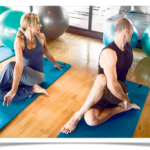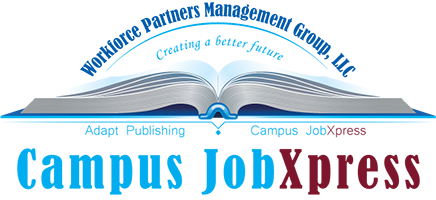
by cjxpadmin | Mar 1, 2012 | First Issue, March 2012 Magazine
 You know how it starts. “I need to rest; a small nap after work won’t hurt.” Maybe a “I don’t have time to work out, I’m busy with work all day!” and my fave “It’s just an innocent cookie to tide me over till lunch, what could it hurt?”
You know how it starts. “I need to rest; a small nap after work won’t hurt.” Maybe a “I don’t have time to work out, I’m busy with work all day!” and my fave “It’s just an innocent cookie to tide me over till lunch, what could it hurt?”
However it happened, you are now out of shape. Don’t worry though! The first step is admitting that you could use some help. And that’s where we come in. We are going to debunk some myths that will hopefully make getting fit a little easier while you work!
Myth 1: You have to do an hour of cardio all at one time to get the benefits.
Truth: Wrong. Though doing it one time is pretty ideal, you can fit in 10 minutes anywhere! Do some jumping jacks on your break. Go up and down the stairs of your office building. Morning classes? Try walking the long way to your class instead of picking the closest parking spot. Don’t have time early in the morning? If you’re a night owl, get your groove on before bed! It’s all about getting your blood pumping when you can. Some activity is better then no activity.

Myth 2: All you have to do is exercise and you’ll lose weight.
Truth: If only that were true. While you can be healthy at any size, if you want to lose weight around your middle or get into those jeans you wore in high school, you may have to give up grandma’s cookies — at least for a while. The best way to stave off snacking problems is to keep healthy snacks around. Instead of grabbing those Oreo cookies, maybe some apple or orange slices will do. Or if you have to have a sweet treat, you can now buy 100 calorie packs of cookies, crackers, and a lot of other snacks. Most cravings come about because you want something you can’t have at the moment. No one sets out to eat a whole can of Pringles, but by keeping a smaller can, you can have your cake or chips and eat them too!
Myth 3: You have to do aerobics.
Truth: If hopping around a gym in a leotard and 80’s like onesies is not your bag, try playing soccer. Join a martial arts class or join a basketball club. Not a sports fan? Zumba is a style of aerobics that’s more like dancing. Pilates is a great choice if you want to work out and relax. Too ambitious for you? Walking around the black for 30 minutes is another way of getting your blood going. You can also take the kids if you’re one of those busy parents who can’t find a sitter. Did we mention jumping jacks for 10 minutes? Awesome….

Myth 4: You need to join a gym to get fit.
Truth: By no means do we want you to throw away your gym membership, but for those of you who are tight on money or you’re not a joiner, there is hope. You can work out from any space. Like say for instance…your living room! That’s right! You don’t need a ton of equipment to get in shape. You can use towels for resistance bands, chairs for back and arm work and the floor for ab work. There is literally tons of free information about working out from home. The only thing that’s stopping you is you!
Myth 5: If I’m not sore, then I didn’t work out properly.
Truth: Okay, yes, if it’s too easy, you may want to work out a bit more. But soreness is caused by tiny tears in your muscle fibers. If you switch up your routine every once in a while, then, some soreness is to be expected. However, being sore after every work out means you’re not allowing your body to heal. Your muscles need a break or they won’t get stronger. Work on a different muscle group while another one is healing. You’ll still get your workout in, but it’ll give your body time to heal.
Myth 6: I’m hungry!
Truth: True, you might be hungry. If so, you should eat — no question about it. But! Before you go for that gyro, drink a glass of water. Sometimes that craving for food is actually a craving for water. So whenever you’re hungry, grab some agua and give it a few minutes. If you’re still hungry, get something to eat. It doesn’t have to be a four course meal, but there is nothing good about going without food for the sake of weight loss.
Myth 7: Water isn’t that good for you.
Truth: While we’re on the topic of water, there is currently a rumor that water isn’t that good for you.
![Dr. Pepper]()
by cjxpadmin | Mar 1, 2012 | Employer Spotlight, First Issue, Food Court, March 2012 Magazine
 Dr. Pepper originated in Waco, Texas. Dr Pepper was created around 1885 by a young pharmacist named Charles Alderton. He introduced it to the owner of Morrison’s Old Corner Drug Store. He liked it so they began selling it to a few local customers. After collaborating on the production, Mr. Morrison, being the owner of the drug store, renamed the drink “Dr Pepper.” In the 1950’s, they began having trouble keeping up with manufacturing enough Dr Pepper for their customers.
Dr. Pepper originated in Waco, Texas. Dr Pepper was created around 1885 by a young pharmacist named Charles Alderton. He introduced it to the owner of Morrison’s Old Corner Drug Store. He liked it so they began selling it to a few local customers. After collaborating on the production, Mr. Morrison, being the owner of the drug store, renamed the drink “Dr Pepper.” In the 1950’s, they began having trouble keeping up with manufacturing enough Dr Pepper for their customers.
They collaborated with Robert Lazenby in using his Ginger Ale Company to manufacture the drink. This company later became the Dr Pepper Company. In 1904, Dr Pepper was introduced to 20 million people at the 1904 World’s Fair Exposition in St. Louis. The Dr Pepper Museum opened its door to the public in 1991 where they still sell old-fashioned sodas from a working soda fountain.
300 South 5th Street, Waco, TX 76701
(254) 757-1025

 Advancing our global momentum
Advancing our global momentum
From 1899-1902, the Hutchinson Bottle was used, followed by three versions of a Straight-sided Bottle from 1900-1916. Then from 1916-1957 came the Embossed Contour Bottle followed by the Applied Color Label Bottle from 1957 to Present. Also in 2007, Coca-Cola introduced the Aluminum Contour Bottle still offered today.The Coca-Cola Company began serving a delicious and refreshing sparking beverage 125 years ago in Atlanta, Georgia. With that first moment of refreshment came a thirst for more that continues to this day
8400 imperial DR, WACO
(254) 741–1335
![Dr. Pepper]()
by cjxpadmin | Mar 1, 2012 | Employer Spotlight, First Issue, Hanging Closet, March 2012 Magazine
 shopping at target. see. spot. save.
shopping at target. see. spot. save.
Just like its Bullseye logo, Target’s history comes full circle. Their department-store roots evolved into discount-store savvy. Their first-in-the-industry innovations led to retail revolutions. In 1962, Target opened its first store and it was heralded as a “new idea in discount stores.” Target differentiates itself from other retail stores by combining many of the best department store features — fashion, quality and service — with the low prices of a discounter. It was created as “a store you can be proud to shop in, a store you can have confidence in, a store that is fun to shop and exciting to visit.”
5401 BOSQUE BLVD, Waco
(254) 399-0067

save money. live better. Walmart serves customers and members more than 200 million times per week at more than 9,759 retail units under 60 different banners in 28 countries. A leader in sustainability, corporate philanthropy and employment opportunity, Walmart ranked in the top ten among retailers in Fortune Magazine’s 2010 Most Admired Companies survey. Saving people money to help them live better was the goal that Sam Walton envisioned when he opened the first store more than 40 years ago. Today, this mission is more important than ever to its customers and members around the world.
4320 franklin Ave, Waco(254) 751-0464
1521 INTERSTATE 35 N, BELLMEAD (254) 867-8084
600 HEWITT DR, WACO(254) 666-9021

by cjxpadmin | Mar 1, 2012 | First Issue, Job Market, March 2012 Magazine
HIRE FROM AMONG THESE 9 GROUPS
- Long-Term TANF Recipient*- Member of a family that: 1) received Temporary Assistance for Needy Families (T ANF) payments for at least 18 consecutive months ending on the hiring date, or 2) received TANF payments for any 18 months beginning after August 5, 1997, and the earliest 18 month period ended during the past 2 years prior to the hiring date, or 3) whose family stopped being eligible for TANF payments because Federal or State law limited the maximum time those payments could be made, and the individual is hired not more than 2 years after such eligibility ended.
*Note. Based on the Internal Revenue Service’ s 2003 Revenue Ruling, members of these four groups (i.e., Veteran; Short and Long-Term TANF; and SNAP Recipient groups) need not receive the assistance/benefits period if the family received it for the entire period and the individual was on the grant and thus received such assistance benefits for at least one day of the specified period (see TEGL #: 20-04, March 18, 2005).
- Other TANF Recipient* — Member of a family that received TANF payments for any 9 months during the 18-month period ending on the hiring date.
- Veteran*- Member of a family that received Supplemental Nutrition Assistance Program (SNAP) benefits (food stamps) for at least a 3-month period during the 15-month period ending on the hiring date, or a disabled veteran entitled to compensation for a service-connected disability hired within one year of discharge from active duty, or unemployed for a period totaling at least 6 months of the year ending on the hiring date.
- 18-39 Year-Old SNAP (Food Stamps) Recipient*- Member of a family that received SNAP benefits (food stamps) for either the 6-month period ending on the hiring date, or for at least 3 of the 5 months ending on the hiring date in the case of a family member who ceased to be eligible for such assistance under Section 6(o) of the Food Stamp Act of 1977.
- 18-39 Year-Old Designated Community Resident* — Individual who lives within an Empowerment Zone (EZ), or Rural Renewal County (RRC).
Note: P .L. 111-312 reauthorized each HUD- designated urban Empowerment Zone (EZ) and each USDA-designated rural EZ from January 1, 2010 through December 31, 2011.
- 16-17 Year-Old Summer Youth – Individual who works for the employer between May 1 and September 15, and lives in an EZ*.
- Vocational Rehabilitation Referral – Disabled person referred to the employer upon completion of (or while receiving) rehabilitation services approved by the State, Ticket-to-Work Program, or the Department of Veteran Affairs.
- Ex-Felon – Individual convicted of a felony and hired within one year after the date of the conviction or release from prison.
- SSI Recipient – Individual who received Supplemental Security Income benefits for any month ending during the past 60-day period ending on the hiring date.
HOW TO FIGURE THE WOTC…
For most target groups, the WOTC can be as much as $2,400. It is based on qualified wages paid to the new hire for the first-year of employment. Generally, qualified wages are capped at $6,000. The credit is 25% of qualified first-year wages for those employed at least 120 hours and 40% for those employed 400 hours or more.
For Disabled Veterans, the WOTC can be as much as much as $4,800 with qualified wages capped at $12,000.
For Long-Term TANF Recipients, the tax credit can be as much as $9,000, with qualified wages capped at $10,000 for a combined 2-year period.
For Summer Youth, the WOTC can be as much as $750 during the 90-day period of employment with wages capped at $3,000.
For employers to qualify for the WOTC, the new hire must begin work after December 31, 2005 and before January 1, 2012. ?

by cjxpadmin | Mar 1, 2012 | First Issue, Job Search, March 2012 Magazine

A personal marketing package is an individual’s first introduction to a prospective employer.
That is why it is very important for you to make the appropriate selection when you are getting ready to do your resume. There are many selections to make, such as style, format, font type and size, content as well as the color and type of paper where you will print it. Your resume should be accurate, neat, attractive, error-free and as professional as one wants to be perceived. The following instructions will assist you in putting into words what you have done in your career and how to make an excellent presentation of yourself to appeal to a potential employer
Sections of a Resume
There are eight sections to your resume. They are:
- Personal Information
- Summarized Highlights
- Work Experience
- Education
- Skills
- Training
- Awards and Certificates and
- References
Detailed instruction is provided on items or information that should go in each section.
Preparation of Your Resume
In order to be able to create a great resume, a little preparation is involved. Create a data sheet that encompasses all of the information above and fill it out as you would an application. Use this document to type out your resume. With everything in order, it’s as simple as 1-2-3 to prepare your resume.
Also, remember to take this document with you once you have earned an interview because many times, companies will ask you to complete an application regardless of you having a resume. This data sheet will have all your information spelled out with accurate dates, company names and telephone numbers so that you don’t have to scramble for information or take precious interview time to call your references or friends.
Typing Your Resume
When you are ready to type your resume, take the time to think through the job duties and responsibilities that you had on your jobs and positions. You want to make your entries informative and understandable but you also need to think about being concise. Interviewers do not take a lot of time when they are reviewing resumes, even when they are sitting in front of you. That is why you will need to bullet your job duties so that it can be scanned and viewed easily and quickly. Make sure that your verbs and your adjectives are accurately used to best describe what it is you can do and what you are all about.
To See More on Resumes…..
Go to www.wpmgnetwork.com and either sign in or register. Create a username and a password to give you access to the different types of resume formats. Learn the difference between chronological resume, functional resume and a combination resume. Check out the Action Verbs Section,
(Click Below to Continue Reading…)

by cjxpadmin | Mar 1, 2012 | First Issue, Job Readiness, March 2012 Magazine
The Interviewing Process Can Be Demanding, But Rewarding.

 One of the most important part of the interview is, of course, you know it, appearance! Be impressive, but not overly dressed and create a great first impression. This is what the interviewer will based their opinion on from the very start. Also, remember to remove any unusual piercings and try to cover up any tattoos, just for the sake of the interview.
One of the most important part of the interview is, of course, you know it, appearance! Be impressive, but not overly dressed and create a great first impression. This is what the interviewer will based their opinion on from the very start. Also, remember to remove any unusual piercings and try to cover up any tattoos, just for the sake of the interview.
Of course, you know to be timely, but go beyond that and give yourself at least 15 minutes of “calming down and getting yourself together” time. This will allow you to get a little refreshed, find your resume or any other documents you will be needing. Sometimes, some companies will ask you for other information and you may have to fill out something else so give yourself plenty of time to do this and still be ready for your interview.
Another important part of the interview is the questions and answers session. This doesn’t just mean that the employer will ask YOU questions. It also means that you must be prepared with vital questions of your own so that you can ask your interviewer. Be interested in the company you are interviewing with and know a bit about their history and background. Job applicants who don’t ask questions make interviewers lose confidence in them and it makes them feel that you might not possess the ability to take on a job as great as the one they are offering you.
When being interviewed for a job, be sure to look the interviewer in the eye when he/she is talking to you. There is nothing that looks like disinterest if the interviewer is talking to you and you are looking out the window or cleaning your nails or worse than that, checking your email messages or texts on your phone. A Big NO NO!!!
Also two other very important aspects of the interview are an enthusiastic smile and a firm handshake. I don’t mean smile at everything he or she says and I don’t mean break the person’s hand when you shake it. I just mean exhibit a friendly personality with a smile here and there and a handshake that says, “I am confident!”
 Questions You Should Be Ready To Answer.
Questions You Should Be Ready To Answer.
These are questions that are pretty standard. In the blue box are questions an interviewer may ask you and in the green box are questions you should be prepared to ask of the interviewer. For examples of the answers to these questions and more questions, go to www.wpmgnetwork.com/tlntacdmylulac and either sign in or register to go to the website and look up the publication, Interviewing Gets the Job.
While there, check out some of the other publications such as Introduction to Resume Writing, Web-Based Applications or Salary Negotiations. ?


 You know how it starts. “I need to rest; a small nap after work won’t hurt.” Maybe a “I don’t have time to work out, I’m busy with work all day!” and my fave “It’s just an innocent cookie to tide me over till lunch, what could it hurt?”
You know how it starts. “I need to rest; a small nap after work won’t hurt.” Maybe a “I don’t have time to work out, I’m busy with work all day!” and my fave “It’s just an innocent cookie to tide me over till lunch, what could it hurt?”





 shopping at target. see. spot. save.
shopping at target. see. spot. save.






 Questions You Should Be Ready To Answer.
Questions You Should Be Ready To Answer.